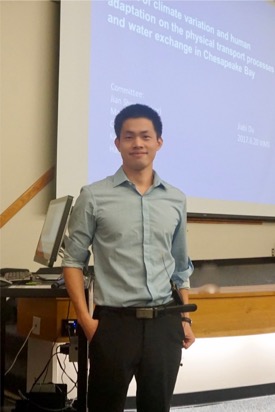Best Student Paper Awards
Each year a committee of faculty and students undertakes the difficult task of choosing the best journal articles from the many high-quality papers written by VIMS graduate students. Each paper considered is either accepted, in press, or published in a high-quality, peer-reviewed journal. The papers reflect the superb quality of the research conducted by VIMS students and the outstanding mentoring of their advisors. Papers are judged for the scope of problem, degree of challenge, magnitude of student effort, hypothesis formulation and testing, and writing style.
This year, the committee members—Donna Bilkovic, Rich Brill, Matt Kirwan, Taylor Goelz, and Ryan Carnegie—evaluated 12 papers.
Ph.D. Category
 This year’s winner of best paper by a Ph.D. student goes to Jiabi Du for “Tidal response to sea-level rise in different types of estuaries: the importance of length, bathymetry, and geometry” in Geophysical Research Letters.
This year’s winner of best paper by a Ph.D. student goes to Jiabi Du for “Tidal response to sea-level rise in different types of estuaries: the importance of length, bathymetry, and geometry” in Geophysical Research Letters.
In his paper, Jiabi analyzed how tidal range responds to sea-level rise across a spectrum of estuaries, using both theoretical analysis and numerical models. His work showed that the change of tidal range in response to sea-level rise varies with distance within an estuary and among different types of estuaries.
Tidal range is likely to decrease with sea-level rise in short estuaries and in shallow tidal creeks, while increasing in estuaries of intermediate length. This work will have far-reaching implications for coastal management and policy, including marsh conservation and restoration and assessments of infrastructure risk.
Master's Category
 This year’s choice for the best paper by a Master’s student goes to Fei Da for "Impacts of Atmospheric Nitrogen Deposition and Coastal Nitrogen Fluxes on Oxygen Concentrations in Chesapeake Bay.”
This year’s choice for the best paper by a Master’s student goes to Fei Da for "Impacts of Atmospheric Nitrogen Deposition and Coastal Nitrogen Fluxes on Oxygen Concentrations in Chesapeake Bay.”
Fei’s paper appeared in JGR-Oceans and was co-authored by Marjy Friedrichs and Pierre St. Laurent. It describes a 3-D modeling analysis that examined the previously unappreciated impacts that nitrogen from the atmosphere and coastal ocean has on Chesapeake Bay hypoxia. In doing so, he provided insight into the importance of these nutrient sources with regard to Bay geography, seasonality, and wet versus dry years.

